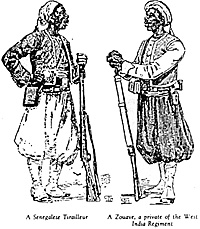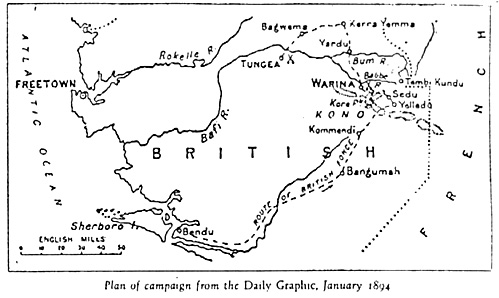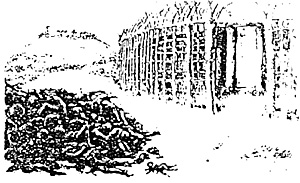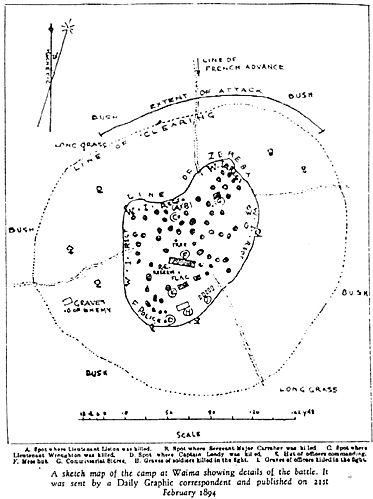 Stemming from events beginning with the construction of the Suez canal, continuing with the Egyptian War, Fashoda and French advances in West Africa there was a ‘cold war’ between England and France from about 1880 to 1900. The English War Office set up a special committee investigating the possibilities of a French invasion. The “Landing Places Committee” printed a secret report in 1894 that stated they thought all of French maritime resources would be involved and projected an invasion force of “13,548 officers and men, 679 horses, 24 guns and 76 carriages”.
Stemming from events beginning with the construction of the Suez canal, continuing with the Egyptian War, Fashoda and French advances in West Africa there was a ‘cold war’ between England and France from about 1880 to 1900. The English War Office set up a special committee investigating the possibilities of a French invasion. The “Landing Places Committee” printed a secret report in 1894 that stated they thought all of French maritime resources would be involved and projected an invasion force of “13,548 officers and men, 679 horses, 24 guns and 76 carriages”.
At the same time as that report was being prepared the English and French were experiencing problems with the Sofas in West Africa. The French had been experiencing attacks by the Sofas for a number of years and had dispatched punative expeditions several times against the Sofas and their leader Samory. This time the Sofas were disrupting the area between French and English (Sierra Leone) territory and were burning villages and capturing villagers for the slave trade so they could buy repeating rifles. Sofa forces consisted of both foot and mounted units.
The campaign and final battle screams to me for a table top scenario. The following is a description of only one action, there are many more that could be made into more than one campaign, but this has the best information.
 The English sent an expedition against the Sofas commanded by Col. Ellis from Sierra Leone. The expedition was punitive in nature because of Sofa attack and burning of two towns belonging to a British treaty chief. The Expedition consisted of:
The English sent an expedition against the Sofas commanded by Col. Ellis from Sierra Leone. The expedition was punitive in nature because of Sofa attack and burning of two towns belonging to a British treaty chief. The Expedition consisted of:
- Royal Engineers: 2 Off. and 10 NCOs and other ranks
Army Medical Corps: 1 Off
Medical Staff and Fixed Hospital Establishment: 2 Off and 5 NCOs and men
Sierra Leone Frontier Police: 1 Off and 47 men
West India Regiment (known popularly as Zouaves), 1st Battalion: 11 Off and 369 men (includes a few English Warrant Off and NCOs)
Food, supply and ammo carriers: 850 men
Medical hammock carriers: 150 men (approximately 6 per hammock)
Two guns (7 pounder mountain guns)
The West India Regiment was in campaign dress of baggy blue trousers with white spatterdashers, blue service jackets and black pillbox hat, they carried .303 Martini rifles each man carrying 20 rounds. In Freetown the WIR wore baggy blue trousers, white spatterddashers, white shirt, a gold-embroidered red zouave jacket and a white turban wound around a red fez. The Sierra Leone Police Force was dressed in blue serge jumpers, blue shorts, red fez, black cummerbund and black leather equipment.
British Expedition Principals:
Lt. Col. A.B. Ellis: Commander of the expedition
Capt. E.A.W. Lendy: Inspector General of the Sierra Leone Police Force
Lt. G.W.Gwynn, RE, Intelligence Chief
Major Bor, West India Regt
French Force:
21 Tirailleurs Senegalese
1000 Kono natives
25 Tirailleurs Senegalese reinforcements
Lt. Gaston Maritz commander of the French expedition against the Sofas
Sofas:
Samory ibn Lamfia Turnay, Commander of the Faithful, Tidjani Khalif of the Sudan
Although they had no regular uniform, the Sofa costume consisted of a jacket and a pair of very short drawers, their heads were partially shaved with one, two, or three tufts of hair long hair. The chiefs wore spurs even with bare feet, individuals might wear a horse blanket, horse guards jacket, spahi uniform, and fake chain mail made of fishing net. The headgear was just as diverse turban, fez, native caps, straw-hats, skull-caps or monkey fur. Weapons consisted of muzzle-loaders, a few chassepots and Gras rifles, large sabers, powder flasks, bullet bags and lots of knives.
Ellis sent a flanking column from Freetown of 2 Off. and 50 men plus a medical Off. and 200 carriers with 20 days supplies for the whole force of 500 men by the colonial steamer Countess of Derby to Rotambo on the Rokelle River. The force had four objectives: 1) form a supply column at Matotoka the town Ellis planned to bring the expedition back to; 2) to lead the Sofas to think that the advance against them would be made from the west; 3) to block the road from Kuniki to Freetown; and 4) bring confidence to the locals to resist the Sofas.
The Countess of Derby returned the next night and with the steamship Badibou the first section of the main force departed unseen for Bendu down the coast from Freetown, from there they would march upcountry by way of Panguma to Kayima in Sofa territory. The second contingent with Ellis and HQ staff departed on board the Countess the following night. The remaining 2 coys of the West India Regt (WIR) had to wait several days.

The force crossed three unfordable rivers and marched at the rate of 12 miles a day for 139 in 7 days. They marched through waist deep swamp and transported over the rivers in one or two canoes with 400 troops and 800 carriers and loads. Gwynn had the worst job scouting through the bush with ten men on either side of the track five paces apart in line and cut their way through the bush. Lendy and the Police force met Ellis at Panguma. Here Ellis wrote a letter to the French at Kissi telling them he was operating in the area against the Sofa.
Ellis moved to Kommendi then onward about seven miles to Tekwiama a town of 3-4 thousand. Here they found the town a stinking horror. Forty headless, bound corpses, bodies of babies and little children too young to be taken as slaves.
On they moved into a belt of Sofa desolated territory 30 miles wide. Just outside the town the advance guard found three envelopes address to Lt Maritz, who was he so far from a French post? They moved on and found the destroyed village of Sumboiyo, then Sengekor, Kranko, and Bondoa. As they moved toward Yelladu Ellis found the nearest French posts to be from four to five days away, no possibility of an encounter with the French, he thought. The forced climbed into the hills and down toward the Sofas who they surprised and ran off. The Sofas met the expedition at the Mofwi River, but had no time to set up defenses. The WIR moved across the river with little difficulty. Gwynn with the advance scouts was hit in the collarbone. The Sofas fell back to Sedu then to Waima. The Sofas blew horns and fired at the column from morning until night. When they got too close the West Indians would fire a few volleys at them. The WIR had a few wounded but only slightly.
Ellis made camp at Wiama confident that he had pushed the Sofas to the west into Sierra Leone where he could take deal with them. Here he waited for the ration column under Capt. Webb of the Army Service Corps to catch up with him. Webb was met and escorted by one Off. and thirty men of the WIR sent from Wiama, the column passed through town after town destroyed by the Sofas. Including one that had been heavily stockaded. Unfortunately, the supplies he received were rum, sugar and cocoa instead of meat and biscuits. He sent forty of the Police to forage for food. The next day was Christmas Eve.
Meanwhile, the French under Lt. Maritz was less than two days away. Earlier in the Month Maritz with twenty tirailleurs, an African Sergeant Oumar and about 1000 Kono natives under Kuriwa went looking for Sofas in the Kono territory. Kuriwaenticed Maritz to attack the Sofas under Porokerri at Tekwiama. The central enclosure/wall at Tekwaima was used for Porokerri and between that wall and the second wall lived the Sofas and their families. The outermost enclosure contained the imprisoned woman captured on slaving raids. And guarded by one section of the Sofa army. There was also another stockaded town at Tekwaima of two enclosures.
Attack
When the time came for Maritz to attack the Sofas he had only his men and fifty Kono warriors. As the force moved against the stockades at dawn the alarm was raised and the force came under heavy Sofa fire. Maritz attacked the main gate and made a dash for the third inner compound. Oumar held the third gate while shot through both legs while the battle raged in the compound. Porokerri and another leader attempted to run by riding out of the gate Oumar shot their horses dead but they managed to escape on foot. The Sofas ran. Maritz could not pursue with only 17 tirailleurs and twenty Konos left. His force had killed two chiefs and captured two chiefs. Being in Kono territory Porokerri and his few men were attacked mercilessly until a few got away. Maritz burned the towns to the ground before marching away. The returning Konos would have to live elsewhere. Maritz was reinforced with 25 more tirailleurs, while his men rested Kuriwa pleaded for help as he told Maritz that Porokerri was back and said he would help Maritz finish Porokerri for good, he was in Waima. Kuriwa then went to the British and told them the same.
 Wiama was a clearing about 200 yards across with long grass and bush around it. In the center was a zeriba in which the troops slept. Maritz and his men crept into the trees and long grass surrounding the camp at 4:30 in the morning. The morning was foggy and rainy although with a full moon.
Wiama was a clearing about 200 yards across with long grass and bush around it. In the center was a zeriba in which the troops slept. Maritz and his men crept into the trees and long grass surrounding the camp at 4:30 in the morning. The morning was foggy and rainy although with a full moon.
The British sentries saw movement in the trees and several shots were fired, Maritz ordered his men to fire and was answered by a ragged volley. He saw white robed figures leaping into action. He focused on those targets believing them to be Arabs who sometimes lead the Sofas. The white targets were English officers in their sleeping attire standing above and commanding their men who were kneeling against the zeriba to fire out.
Lendy’s own men, most of who were green recruits with no discipline, killed him and two other Police. Ellis not seeing any return fire on the south side ordered his bugler to sound cease-fire, which was repeated by the company buglers. Then he heard the firing of Chassepots on the north side and knew they were under attack. The WIR were firing with precision and this told Maritz something was wrong. Maritz attempted to grab a bugle and sound cease-fire when he was hit three times and then fire from the French began to die down. Capt. Baines’ Coy was sent to clear the bush at bayonet, it was just beginning to get light when they began to find French rifles and Senegalese soldiers.
Fortunately Baines recognized the uniform and brought them into the zeriba. Ellis pieced together what had happened and sent his men to find Maritz. At 11 am they located Maritz in the tall grass mortally wounded. Ellis finally learned where the closest French post was, when asked if he knew of the British force Maritz replied no. French losses were ten dead and 26 wounded. British loses were 17 dead and 15 wounded.
In May 1898 the French sent a 1,500 man column against Samory, who still had a 12,000 man army with 120,00 camp followers. The French forced Samory out of Kong territory into dense jungle where his force, used to open spaces, which allowed them to ride, started to disperse. By the end of September Samory and his remaining troops were surrounded and surrendered to a small column of French consisting of sections from two companies commanded by Captain Gourand. Samory and one other chief was captured by Lt. Jacquin and a section of troops. Samory stood trial and was exiled to Gaboon.
SOURCE
Basil Freestone The Horsemen from Beyond, London 1981.
Back to The Heliograph #123 Table of Contents
Back to The Heliograph List of Issues
Back to Master Magazine List
© Copyright 2000 by Richard Brooks.
This article appears in MagWeb (Magazine Web) on the Internet World Wide Web.
Other military history articles and gaming articles are available at http://www.magweb.com